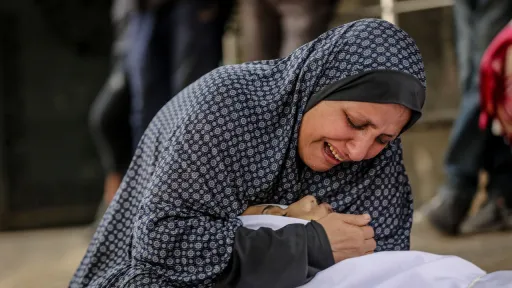By Dayo Yussuf
In a typically dystopian take on the world, the famous British author George Orwell is quoted as having said "the most effective way to destroy people is to deny and obliterate their own understanding of their history".
The ceaseless drone of news about blasts, gunfire and smoke billowing from buildings in the Sudanese capital of Khartoum evokes the same dread in Agnes Kinyua, a lecturer in history specialising in world civilisations at Strathmore University in Kenya.
As she follows the civil war in the African nation, her biggest fear is of history — books, artefacts and entire museums — becoming a casualty in the mayhem
"I have been watching them," Agnes says of those involved in the fighting. "When they burn books, they don't care. They burn everything, they steal, and they destroy. Apart from artefacts, we have historical monuments in Sudan. It's a concern for me, and am sure for anyone else who cares for history."
With no sign yet of the conflict ending, these worries no longer seem unfounded.
"The moment our artefacts are gone, we are going to have non-factual information. History will be lost," Agnes tells TRT Afrika.
Price of conflict
Conflict, especially internal, is one of the most disorganised and unpredictable forms of destruction. It’s a playbook where survival is the only strategy.
There are documented instances of groups in conflict going out of their way to use people either as protection, bargaining chips, or even weapons of war. Relics of the past, including antiquities and monuments, that make up a nation or civilisation's history also happen to be among the more vulnerable targets in a conflict.
"It is important to understand the importance of artefacts. You cannot destroy important historical relics to express anger or to punish an opposing group," says Agnes.
Since fighting broke out in Sudan in mid-April, reports have emerged from Khartoum about sheaves of historical documents being burned to ashes along with books.
A report by Heritage for Peace, an NGO working on preservation of history in Sudan, in late April said the Natural History Museum in Khartoum had a large collection destroyed in a fire.
‘"The museum, which is part of the University of Khartoum, housed a collection of rare plants, specimens of species extinct in Sudan, as well as animals and insects (approximately 100 specimens)," says the report. ‘"Unfortunately, the collection was lost, and the building itself was severely damaged."
The museum in central Khartoum is in Sudanese military territory, and currently out of bounds for civilians.
There have been counter accusations between the warring factions about who is responsible for destroying collections of historical importance.
The paramilitary Rapid Support Forces (RSF), which is fighting against the army, gave a video tour of the National Museum in early June, where it showed boxes containing artefacts intact along with securely wrapped mummies and documents.
The RSF dismissed as "lies and disinformation" reports of its members being involved in the destruction of archaeological and historical institutions.
Whatever be the truth about who's to blame, the fact remains that a lot of civilisational evidence of the past has been destroyed already. Those like Agnes worry that if nothing is done about it, Sudan stands to lose a lot more.
Heritage for Peace says that at least 28 cultural and archeological sites around the country have been targeted, or have suffered collateral damage.
Sudan's place in history
Sudan's importance in the civilisational history of Eastern and Northern Africa can never be overstated.
Sprouting from the heart of the country where the two Niles meet — the Blue Nile and the White Nile — the Kingdom of Kush was known for trading in gold and iron. It was also a critical route between the kingdoms north and south of the Sahara.
Then there are the pyramids and monuments that mark the footprints of the region's relationship with its northern neighbour, Egypt.
This entire cycle of history dating back to 1070 BCE is at risk of going up in smoke if no one stands to protect them amidst the shooting and bombing in Sudan.
"This isn't just about Sudan," says Agnes. "During conflict or any such turmoil, people mostly forget the museums."
Somalia, a country with a rich history and culture, is one such example within the continent.
"Most of it has been lost over years of conflict. Now, we are struggling to connect the history and culture of the region, and preserve it for future generations. We should not allow what happened in Somalia to happen in Sudan, or even West Africa," warns Agnes.
''Curators should fight to protect the artefacts. When they run to safety with their families, they could bring these precious antiquities with them, if they can,'' adds Agnes,
Archaeological experts in Sudan say they have been scrambling to save what they can since the fighting broke out.
''We are trying our best to make sure these monuments, art and artefacts are safe. We want to make sure they are known to everyone," says Ibrahim Musa, general director of Sudan's National Corporation of Antiquities and Museums.
Agnes suggests extending the mandate for peacekeepers to protect these antiquities.
"The United Nations can step in. So can any other organisation with the mandate such as the African Union or ECOWAS. They can help provide security, or at least assist in moving these antiquities to safer places," she says.
According to Heritage for Peace, at least four museums across the Western region of Darfur have been damaged, including the famous Nyala Museum, whose roof was ripped off in shelling, risking further damage to the interior from leakage and rainfall.
Sudan has at least six major museums and many smaller ones scattered across the country.
UNESCO has listed two places in Sudan as World Heritage sites: Meroe Island, home to one of the largest ancient pyramid complexes in Africa, and Jebel Barkal, a sacred sandstone mountain close to tombs, temples and palaces along the Nile.
Every time a bomb goes off and a building is damaged in the ongoing conflict, Agnes and her ilk are filled with Orwellian cynicism.




























